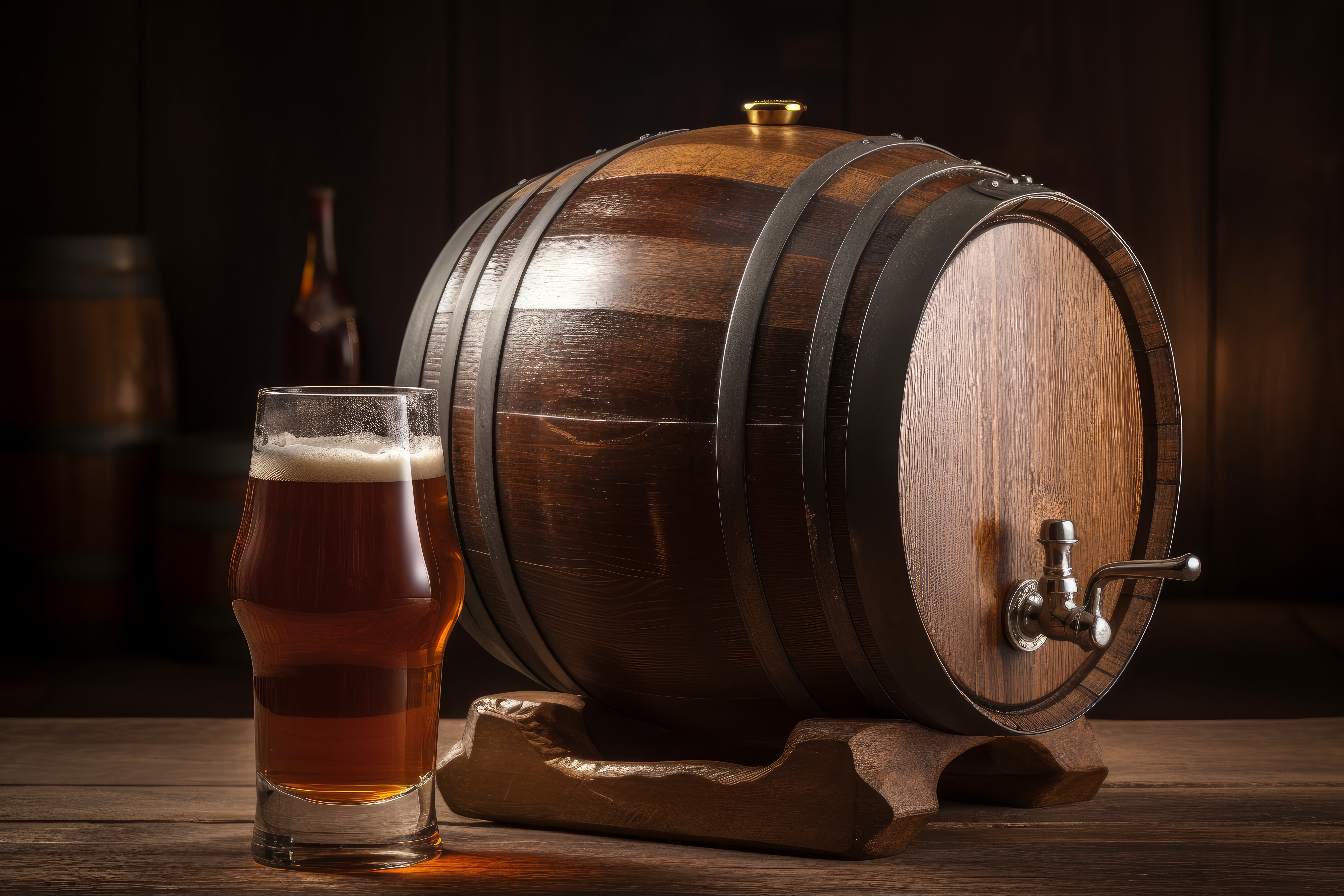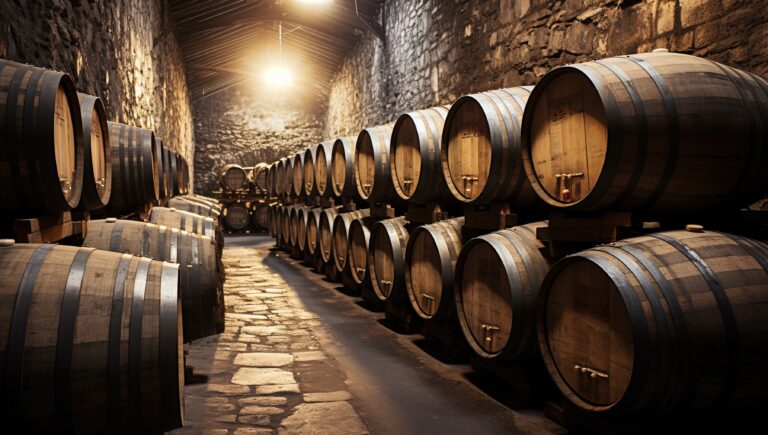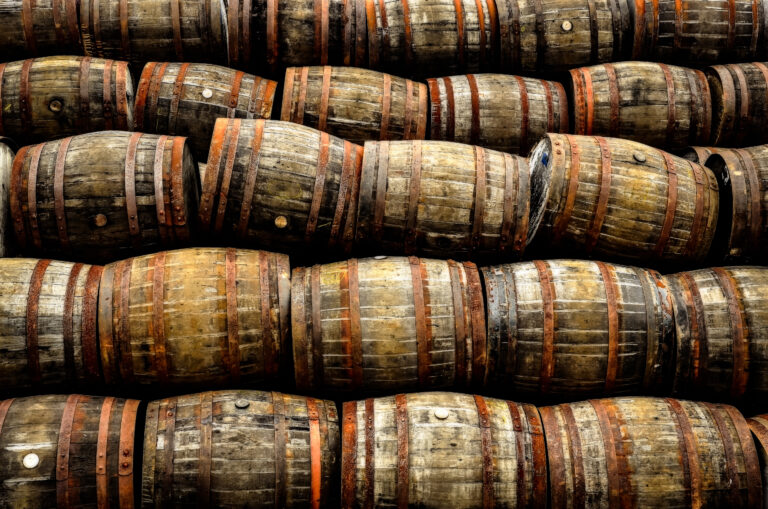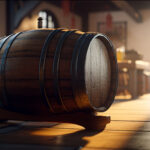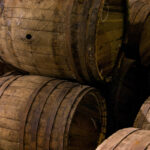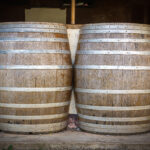Ever wonder why that craft beer you’re sipping has those intriguing whispers of vanilla or a subtle hint of oak? The magic lies in the age-old technique of barrel aging, specifically using pre-loved whiskey barrels. It seems like every other craft brewery is now releasing their own barrel-aged beers, and for good reason. This method allows brewers to truly play, experimenting with different beer styles and aging techniques to unlock layers of unique and complex flavor profiles. The interaction between the beer and the porous wood of the barrel imparts distinctive notes – think warm vanilla, toasted oak, or even a ghost of the spirit that once resided there – something you just can’t replicate in standard stainless steel or aluminum fermenters. Whiskey barrels, in particular, lend a special character, imbued with compounds left behind from the aging whiskey.
So, the next time you pop the cap on a bourbon barrel-aged stout with its sweet caramel notes or a rum barrel-aged sour boasting tropical fruit hints, take a moment to appreciate the humble wood barrels and their crucial role in crafting that intricate flavor journey. Aging beer in whiskey barrels is a true art form, where tradition meets innovation in the pursuit of sublime taste. This practice perfectly exemplifies how craft brewers are embracing age-old methods to push the boundaries of flavor and elevate the entire beer experience.
The Time-Honored History of Aging Beer in Oak Barrels
The story of aging beer in oak barrels stretches back centuries. Originally, brewers relied on wooden barrels simply out of necessity – options were limited. However, it didn’t take long for them to realize the remarkable way barrel aging could enhance the flavor of their brews, and the practice blossomed.
The Contemporary Rise of Barrel Aging in Craft Beer
In recent decades, barrel aging has experienced a significant resurgence within the craft beer movement. Brewers seeking to create complex and distinctive flavors have enthusiastically embraced the technique. Whiskey barrels have emerged as a particularly popular choice, as they generously impart notes of vanilla, oak, and sometimes a subtle echo of the whiskey itself.
Bourbon barrels are frequently employed, bestowing lovely vanilla and caramel undertones upon the beer. On the other hand, rye whiskey barrels contribute a spicier, more peppery character. The duration of the aging process significantly impacts the final flavor profile. Some brewers patiently age their beers for several months, while others extend the process to several years, allowing for a deeper interaction with the wood.
Beyond single-barrel aging, craft brewers also leverage this technique to experiment with blending different beer styles and flavors. Barrel-aged stouts, robust barleywines, and intriguing sour beers have gained immense popularity, leading to captivating variations such as bourbon barrel-aged imperial stouts with their intense richness or rye barrel-aged Flanders red ales with their complex fruit and spice notes.
The Allure of Whiskey Barrels for Beer Aging
Whiskey barrels are ideally suited for the beer aging process for several key reasons:
- Oak Construction: They are crafted from oak, a naturally porous wood that facilitates gentle oxidation and a meaningful exchange of flavors between the beer and the wood.
- Pre-Imbued Flavors: Having previously aged whiskey, these barrels already possess distinctive aromas and flavors that are readily transferred to the beer.
- Ideal Size for Experimentation: Their typical size (around 53 gallons) is perfectly manageable for craft brewers looking to experiment with smaller, more controlled batches.
- Availability and Affordability: Whiskey barrels are relatively plentiful and affordable because whiskey distillers routinely replace them after a single use.
The use of whiskey barrel aging has ignited an explosion of creativity within the craft beer world. So, the next time you savor a barrel-aged brew, take a moment to appreciate the layers of history and craftsmanship contained in every sip. Brewers have tapped into an age-old practice to produce beers as diverse and complex as the imaginations that conceived them.
Why Whiskey Barrels Reign Supreme for Beer Aging
If you’re a dedicated craft beer lover, you’ve likely encountered many brewers who choose to age their creations in used whiskey barrels. Ever wondered about this preference? It turns out, these charred oak barrels impart an incredible array of flavor and aroma compounds to the beer.
Unlocking Complex Flavors from the Wood
The whiskey barrels, being made of oak, contain natural compounds like vanillin, which contribute those delightful vanilla notes. As the beer ages within the wood, it gradually absorbs these inherent flavors. The barrels also generously impart hints of caramel, coconut, and a subtle spiciness.
Furthermore, the charring or “toasting” of the inside of the barrels creates smoky, roasted flavors that slowly seep into the beer. The longer the beer rests, the more pronounced these oak-derived flavors become. Many brewers age their beers for months, or even years, to achieve that perfectly balanced oak-forward taste.
The Boozy Bonus from the Whiskey
Of course, these barrels previously cradled whiskey, so they naturally impart residual whiskey flavors to the aging beer, such as notes of molasses, dried fruit, and a gentle warmth from the alcohol. The specific type of whiskey originally aged in the barrel also influences the final flavor – for instance, barrels that once held bourbon tend to impart sweeter notes compared to those that held rye whiskey.
The Magic of Controlled Oxidation
As the beer ages within the barrels, a minute amount of oxygen gently permeates the wood and interacts with the beer. This controlled oxidation process helps the beer mellow and become smoother, less bitter, and fuller in body. This subtle interaction also contributes intriguing nutty, sherry-like flavors.
Clearly, used whiskey barrels play a starring role in crafting complex and flavorful aged beers. The interplay of oak, char, residual whiskey, and controlled oxidation all combine to create an unmistakable aroma and taste that keeps drinkers coming back for more. It’s no wonder that aged craft beers have become so incredibly popular! The time and meticulous care invested in barrel aging are evident in every rich and satisfying sip.
How Whiskey Barrel Aging Profoundly Impacts Beer Flavor
Barrel aging beer in used whiskey barrels unlocks a spectrum of complex flavors that simply cannot be achieved through traditional brewing methods alone. The porous wood of the barrel actively interacts with the beer, imparting distinct characteristics that vary depending on the specific type of barrel employed.
Bourbon barrels generously impart notes of vanilla, coconut, and sweet caramel. The inherent sweetness from the bourbon barrel creates a beautiful balance when paired with the bitterness of IPAs and the richness of stouts.
Rye whiskey barrels, on the other hand, contribute a spicier and more peppery character. This subtle spice beautifully complements the malt-forward profiles of Scotch ales and the complexity of Belgian-style ales.
The use of peated whisky barrels, such as those from Laphroaig, introduces a smoky and earthy quality, often with intriguing hints of iodine. This smokiness finds a harmonious pairing with the intensity of imperial stouts and the malt richness of wee heavy ales.
As the beer ages, the wood of the barrel undergoes subtle expansion and contraction, allowing minute amounts of oxygen to interact with the beer. This controlled oxidation contributes to the development of complex aromas and flavors reminiscent of sherry, port wine, and dried fruit. Additionally, the tannins present in the wood impart a gentle bitterness that helps to balance the malty and caramelized flavors that develop during aging.
The longer a beer ages in the barrel, the more intricate its flavor profile becomes. However, it’s a delicate balance – if left for too long, the beer can become overwhelmed by woody and oxidative flavors. Mastering barrel aging requires a keen understanding of the optimal contact time to achieve peak flavor.
Barrel aging is truly an art form that continues to gain momentum and popularity within the craft beer community. The sheer variety of barrel types available, from those previously holding wine and spirits to more experimental woods like maple or hickory, provides endless opportunities for brewers to craft truly unique and complex beers. For discerning craft beer lovers, barrel-aged beers offer an extra special and rewarding treat.
The next time you have the pleasure of trying a barrel-aged beer, take a moment to appreciate the subtle nuances of flavor and aroma imparted by the wood. With each sip, you’ll experience the brewer’s skill and patience in coaxing the very best flavors from the marriage of wood and beer. Barrel aging beer is undeniably a labor of love that yields exceptional results.
The Intricate Process of Aging Beer in Whiskey Barrels
The aging process for craft beer in whiskey barrels involves several crucial steps to cultivate the desired flavor profile.
Meticulously Selecting the Barrels
The initial step involves carefully selecting used bourbon or whiskey barrels. These barrels are chosen for their ability to impart specific notes of vanilla, oak, and a hint of smoke to the aging beer. The precise type of barrel, including its char level and size, will influence the intensity of the bourbon flavor imparted. A higher char level generally translates to more pronounced bourbon flavor. Furthermore, the duration the barrel was used to age bourbon also plays a role – longer use typically results in less intense bourbon flavor.
Thoroughly Cleaning and Preparing the Barrels
Before the beer even touches the barrels, they must undergo a rigorous cleaning and preparation process. This involves rinsing the barrels with water to remove any loose debris, followed by steaming and sanitizing them to ensure a clean environment for the beer. After sanitization, the barrels are left to stand, allowing any residual water to drain out. This crucial step prevents excess water from diluting the beer during the aging process.
Carefully Filling and Sealing the Barrels
Once the barrels are properly prepared, they are carefully filled with the chosen craft beer. To prevent unwanted oxygen exposure, the filled barrels are then securely sealed. The typical aging time for beer in barrels ranges from 3 months to as long as 3 years, depending on the brewer’s specific goals and the desired flavor profile. This aging time will significantly shape the final taste of the beer.
Diligently Monitoring the Barrels
Throughout the entire aging process, the barrels require regular monitoring. Factors such as temperature, humidity levels, and gravity readings are meticulously recorded. The barrels are also routinely inspected for any signs of leaks or other potential issues. Brewers will periodically sample the beer to assess how the flavor is developing and to determine the optimal time for bottling.
Bottling the Final, Flavorful Product
When the beer has reached the desired flavor profile, it is finally ready for bottling or kegging. Through the careful aging process utilizing whiskey barrels, the brewer has crafted a unique bourbon-flavored beer. The final product represents a harmonious blend of the original beer style with distinctive undertones of bourbon, oak, and a subtle smokiness.
Aging craft beer in bourbon barrels demands both patience and skill. However, when executed correctly, it yields a complex and flavorful beer unlike any other. The marriage of craft beer and bourbon barrels creates a truly distinctive and rewarding taste experience for beer lovers.
Popular Beer Styles That Thrive with Whiskey Barrel Aging
Certain beer styles particularly benefit from the nuanced flavors imparted by whiskey barrel aging:
Stouts and Porters
Stouts and porters, with their inherent rich and malty character, form a perfect foundation for the influence of oak and whiskey notes. The barrels contribute flavors of vanilla, caramel, and sometimes a gentle smokiness that beautifully enhances the chocolate and coffee tones already present in these dark beers. Have you ever experienced a bourbon barrel-aged stout? The boozy, oak-infused flavors transform an already robust stout into a truly complex and contemplative sipper.
Barrel-Aged Sours
Sour beers that undergo aging in whiskey barrels develop intriguing layers of flavor resulting from the dynamic interplay between the tartness of the beer and the spirit-soaked wood. The barrels tend to temper the sourness slightly while adding complementary notes of oak, bourbon, or rye. Barrel-aged sours often exhibit a pronounced vanilla aroma and flavor. Some brewers also introduce fruit to barrel-aged sours, creating a delightful medley of sweet, tart, and oaky flavors.
Barleywines
The intense, malty sweetness of barleywine style ales finds a magnificent partner in whiskey barrel aging. As barleywines age in these barrels, they develop sherry-like oxidized notes that seamlessly blend with familiar bourbon flavors such as vanilla, toast, and spice. The inherent boozy warmth of barleywine is further enhanced by the bourbon character imparted from the barrels. Savoring a well-aged barleywine that has been barrel-aged is a true delight for dedicated beer geeks.
Imperial Stouts
Some of the most highly sought-after barrel-aged beers are imperial stouts that have been aged in bourbon barrels. The rich, roasted malts of imperial stouts provide a perfect canvas for the complex flavors of bourbon barrels. Notes of chocolate, coffee, and dark fruit meld beautifully with vanilla, caramel, and oak. The high alcohol content of imperial stouts also makes them well-suited for extended barrel aging. These barrel-aged behemoths, often released as limited edition brews, have achieved legendary status within the craft beer community.
Renowned Craft Breweries Celebrated for Their Whiskey Barrel-Aged Beers
An increasing number of craft breweries are enthusiastically experimenting with aging beer in used whiskey barrels to unlock complex and nuanced flavors. The porous wood of the barrels allows the beer to absorb the residual whiskey flavors, resulting in truly unique taste profiles. Several breweries have established a strong reputation specifically for their exceptional barrel-aged beers.
Goose Island Brewery
A true pioneer in the realm of bourbon barrel-aged stouts, Goose Island’s iconic Bourbon County Stout is aged in Heaven Hill bourbon barrels. This acclaimed beer boasts hints of vanilla, oak, and bourbon, culminating in a remarkably smooth finish. Goose Island also produces noteworthy variations such as Bourbon County Barleywine and Proprietor’s Bourbon County Stout.
Founders Brewing Co.
Founders KBS (Kentucky Breakfast Stout) is a celebrated imperial stout aged for a full year in oak bourbon barrels. It exhibits distinct notes of vanilla, coffee, and rich chocolate, all underscored by a noticeable bourbon kick. Their CBS (Canadian Breakfast Stout) takes barrel aging a step further, aged in both bourbon and maple syrup barrels, resulting in a unique sweet and savory flavor profile.
Firestone Walker Brewing Company
Firestone Walker’s dedicated Barrelworks program is entirely focused on the art of barrel-aged beers. Their Anniversary Ales are aged in a diverse selection of spirit barrels, creating uniquely complex flavors that vary with each annual release. Another highly regarded barrel-aged beer in their lineup is Parabola, a robust imperial stout aged in bourbon barrels.
New Holland Brewing Company
New Holland is well-known for its impressive range of barrel-aged beers, including Dragon’s Milk, a rich imperial stout aged in bourbon barrels for over a year. This popular brew offers decadent flavors of chocolate, coffee, vanilla, and distinct bourbon notes. They also produce a Bourbon Barrel Aged El Rojo red ale and a Rum Barrel Aged ISB barleywine-style ale, showcasing their versatility in barrel aging.
The sheer variety of barrel-aged beers now readily available underscores the boundless creativity within the craft beer scene. By aging their beers in used spirit barrels, brewers are able to craft an array of multi-dimensional flavors that simply cannot be found in traditionally brewed beers. The results are distinctive and memorable brews that continually raise the bar for the entire craft beer industry.
Unraveling the Tasting Notes and Flavor Profiles of Barrel-Aged Beers
The intricate aging process within whiskey barrels imparts a range of distinctive flavors to craft beers. As the beer patiently rests within the barrels, it absorbs the natural aroma compounds present in the wood, as well as the residual whiskey that has permeated deep into the wood’s grain. This interaction gives barrel-aged beers complex tasting notes that can vary significantly depending on the specific type of barrel used.
The Sweet Embrace of Bourbon Barrels
Beers aged in bourbon barrels often exhibit prominent notes of vanilla, sweet caramel, and sometimes a hint of buttery butterscotch, alongside subtle undertones of smoke or even coconut. Bourbon itself tends to have a sweeter profile, and these characteristics are readily transferred to the beer. Popular styles that thrive with bourbon barrel aging include rich imperial stouts, complex barleywines, and malty scotch ales.
The Tropical Allure of Rum Barrels
Rum barrels lend a distinctly tropical character to beers, often imparting flavors reminiscent of ripe banana, juicy mango, and sweet pineapple. They also contribute notes of rich molasses and brown sugar sweetness. Fruited sour beers or complex Belgian-style ales often pair beautifully with the unique influence of rum barrel aging. The tart and funky base beer can provide a wonderful counterpoint to the barrel’s inherent sweetness.
The Vinous Elegance of Wine Barrels
Wine barrels contribute vinous and jammy fruit flavors, along with an often subtle oaky and tannic structure. Beers aged in wine barrels may develop tasting notes of ripe cherries, dark plums, or black currants. Sour beers are frequently aged in wine barrels, as are some malt-forward Belgian-style ales. The residual wine compounds can enhance the fruitiness of the beer and create a harmonious blend of flavors.
The Intriguing World of Unique Barrels
Some adventurous craft brewers push the boundaries even further by experimenting with barrels that previously held maple syrup, tequila, or other distinctive spirits. Maple syrup barrels can impart delightful notes of maple, sweet caramel, and even hints of pancake batter. Tequila barrels often contribute agave, bright lime, and a subtle spiciness. Furthermore, brewers may create even more unique flavor profiles by blending multiple barrel-aged beers or by adding barrel staves (pieces of wood) directly to tanks during secondary fermentation. The possibilities for creative experimentation are truly endless!
Barrel aging is a genuine art form, and experiencing barrel-aged beers is akin to embarking on a flavor adventure. You can never be entirely certain how the barrel will uniquely impact the final flavor until you take that first sip. If you appreciate complex, layered flavors in your beer, you’re sure to find immense enjoyment in discovering the diverse tasting notes that barrel-aged brews have to offer.
Best Practices for Cellaring and Serving Your Prized Barrel-Aged Beers
Once you’ve acquired a carefully barrel-aged craft beer, it’s crucial to properly cellar and serve it to ensure you experience its flavors at their absolute best. Here are some valuable best practices to keep in mind:
Selecting the Right Bottles
Opt for thick, tinted bottles that offer protection from light. Harmful ultraviolet rays can degrade the delicate flavor compounds present in barrel-aged beers. Bottles with a tight, reliable seal are also essential for preserving the beer’s carbonation and its aromatic complexity.
Storing Your Beer with Care
Keep your precious barrel-aged beer in a cool, dark environment, away from direct sunlight or any significant sources of heat. A consistently cool closet, a dedicated cabinet, or a proper cellar with a temperature around 55°F (13°C) is ideal. Elevated temperatures can accelerate the aging process, potentially leading to off-flavors, while excessively low temperatures can hinder the desired flavor development.
The Importance of Checking In
As barrel-aged beers continue to mature within the bottle, their flavor profiles will gradually evolve, often becoming more integrated and complex over time. It’s a rewarding practice to periodically taste your beer to monitor how the flavors are developing and to determine when it has reached its peak enjoyment for your personal palate. Once you open a bottle, it’s best to consume it within a few days, as exposure to oxygen can lead to a loss of carbonation and the development of unwanted oxidation notes.
Serving Suggestions to Enhance the Experience
Allow your barrel-aged beer to reach a temperature of around 55°F (13°C) before serving. This slightly warmer temperature range allows the intricate aromas and flavors to fully blossom. Pour the beer into a tulip or snifter glass. The shape of these glasses is specifically designed to trap the volatile aroma compounds, enhancing your overall sensory experience.
Thoughtful Food Pairings
Barrel-aged beers, with their often bold and intense flavors, pair exceptionally well with equally rich and flavorful foods that can stand up to their complexity. Some excellent pairing options include:
- Aged cheddars and creamy Gouda cheeses
- Grilled red meats such as steak, flavorful ribs, or rich duck
- The satisfying bitterness of dark chocolate
- The earthy richness of walnuts and pecans
By following these helpful tips, you’ll be well-equipped to properly cellar and fully savor the complex and nuanced flavors of your cherished barrel-aged craft beer. The entire process of aging and tasting can become a fascinating and rewarding hobby for any dedicated beer enthusiast. Cheers to the journey of flavor discovery!
The Promising Future of Whiskey Barrel Aging in Craft Beer
The practice of utilizing whiskey barrels to age craft beer has witnessed a steady surge in popularity over the past decade. As an increasing number of craft brewers embrace the art of barrel aging, the potential for discovering entirely new and exciting flavor profiles seems virtually limitless.
Continued and Robust Growth
Barrel-aged beer has firmly established itself as a hugely popular segment within the craft beer landscape, and all indications suggest that this trend is here to stay. More and more craft brewers will undoubtedly begin to incorporate aging some of their beers in used whiskey barrels, leading to a continuous stream of innovation and unique offerings. Expect to see an even wider array of imperial stouts, robust barleywines, complex old ales, and other captivating beer styles that have been lovingly aged in bourbon, rye, or even rum barrels.
The Exciting Realm of New Flavor Combinations
The harmonious marriage of beer and spirits barrels consistently yields complex flavors that often transcend the sum of their individual parts. Forward-thinking brewers are increasingly exploring the art of blending different barrel-aged beers or aging the same beer in a variety of barrel types to create entirely novel and captivating taste experiences. We can likely anticipate seeing more intriguing fusions of beer styles and barrel types, such as a delicate Belgian-style tripel aged in aromatic tequila barrels or a bold Russian imperial stout that has undergone a dual aging process in both bourbon and wine barrels.
Navigating Potential Barrel Shortages
Some industry experts have expressed concerns that the growing demand for used whiskey barrels could potentially lead to a shortage, which could, in turn, drive up costs for smaller brewers. However, it’s important to note that most craft brewers require significantly fewer barrels compared to large-scale distilleries. Therefore, a complete shortage seems unlikely as long as distillers maintain their current supply levels or increase production to meet the evolving demand. Furthermore, many resourceful craft brewers are actively experimenting with alternative barrel types, such as those previously used for wine, rum, gin, or tequila, which helps to diversify the options and alleviate pressure on whiskey barrel supplies.
Embracing Innovative New Wood Alternatives
To further expand their creative possibilities and manage costs, some smaller craft brewers are exploring the use of new oak alternatives, such as oak chips, spirals, and cubes, either in addition to or as a substitute for traditional used barrels. These alternatives can effectively impart desirable oak flavor and aroma compounds, such as vanillin, without the need for an entire barrel. The adoption of new wood alternatives, alongside a diverse range of barrel types, will empower even more craft brewers to experiment with the fascinating world of wood-aged beer within their budgetary constraints.
The ingenuity and creativity of craft brewers know no bounds. As the desire to produce exceptional barrel-aged beer continues to grow, brewers will undoubtedly continue to discover innovative and exciting ways to impart unique flavors from both wood and spirits. The future of barrel-aged craft beer looks incredibly promising indeed, filled with exciting new tastes waiting to be discovered.
Final Thoughts on the Art of Barrel Aging
So there you have it – a comprehensive look into the fascinating world of how whiskey barrels impart their distinctive and complex flavors to craft beers during the transformative aging process. The next time you have the pleasure of cracking open a bottle of a barrel-aged stout or a tantalizing sour ale, you’ll hopefully have a deeper appreciation for the intricate flavors and captivating aromas that were carefully crafted through this time-honored technique. Barrel aging is truly an art form that demands patience, experience, and a willingness to embrace experimentation. A heartfelt kudos to the innovative craft brewers who are constantly pushing the boundaries of flavor and creating amazing new taste experiences by skillfully blending barrel aging with diverse beer styles. The results can be nothing short of magical. So, get out there and support your local craft brewery – you never know what delicious new barrel-aged creation might be patiently maturing in their cellar, just waiting to be discovered and savored. Cheers to the incredible world of barrel-aged beer!
